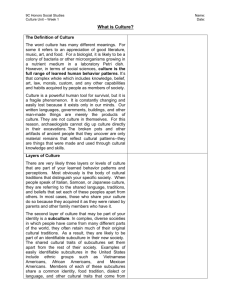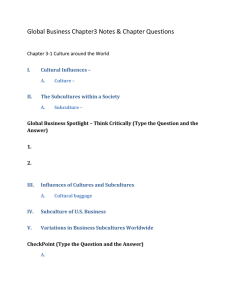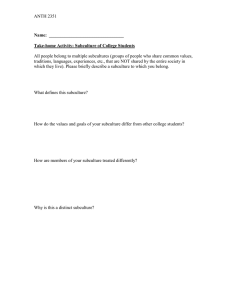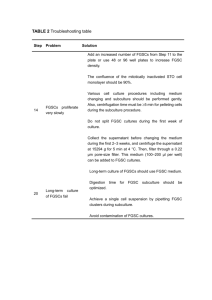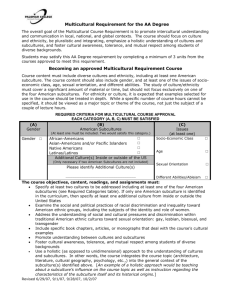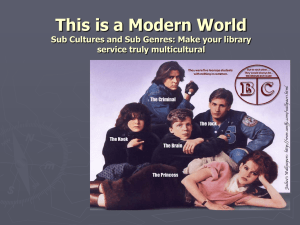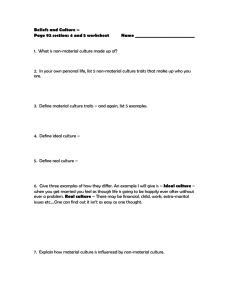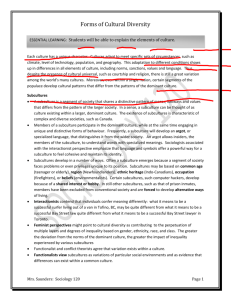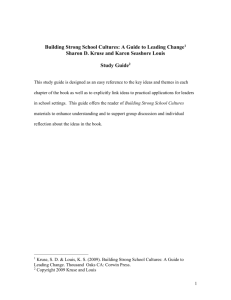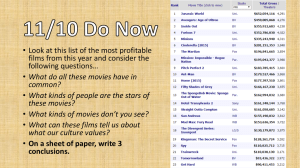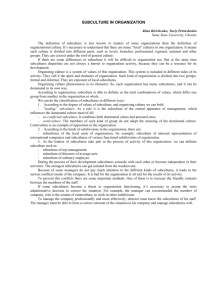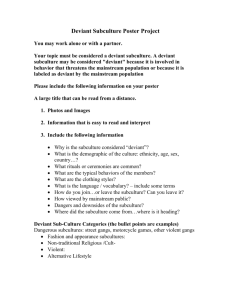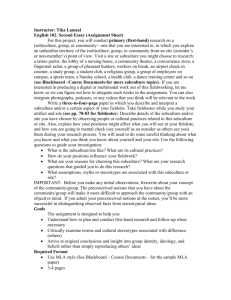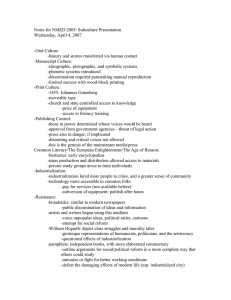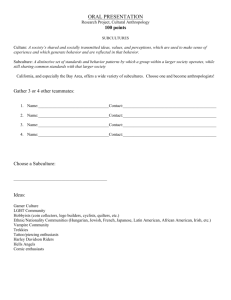What is Culture
advertisement
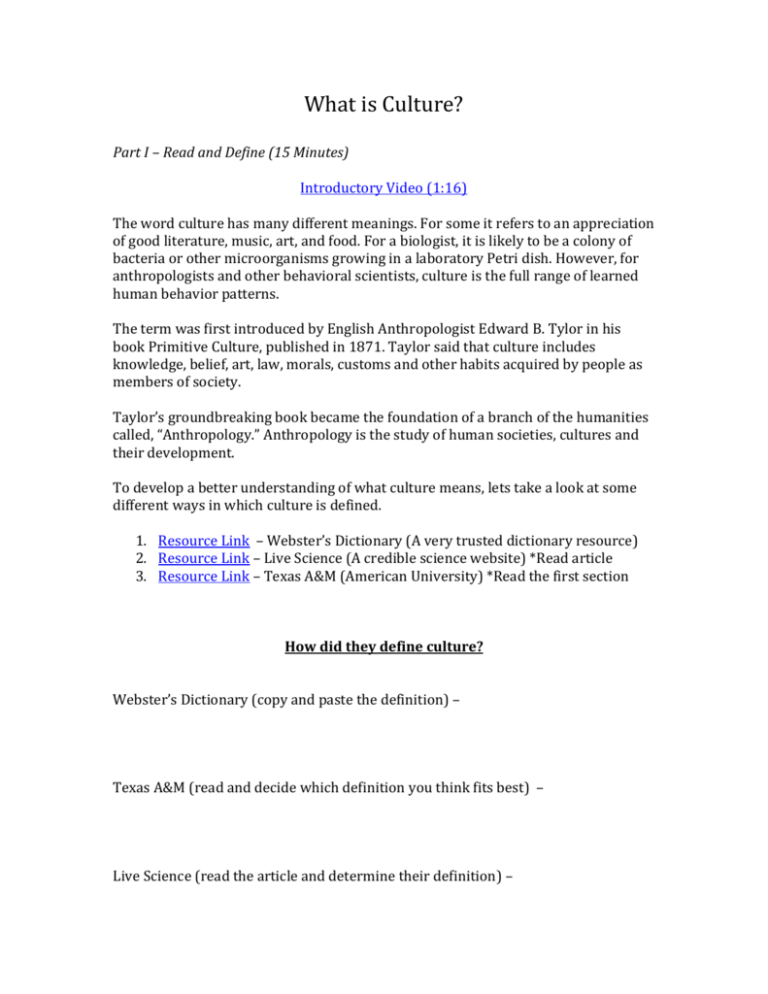
What is Culture? Part I – Read and Define (15 Minutes) Introductory Video (1:16) The word culture has many different meanings. For some it refers to an appreciation of good literature, music, art, and food. For a biologist, it is likely to be a colony of bacteria or other microorganisms growing in a laboratory Petri dish. However, for anthropologists and other behavioral scientists, culture is the full range of learned human behavior patterns. The term was first introduced by English Anthropologist Edward B. Tylor in his book Primitive Culture, published in 1871. Taylor said that culture includes knowledge, belief, art, law, morals, customs and other habits acquired by people as members of society. Taylor’s groundbreaking book became the foundation of a branch of the humanities called, “Anthropology.” Anthropology is the study of human societies, cultures and their development. To develop a better understanding of what culture means, lets take a look at some different ways in which culture is defined. 1. Resource Link – Webster’s Dictionary (A very trusted dictionary resource) 2. Resource Link – Live Science (A credible science website) *Read article 3. Resource Link – Texas A&M (American University) *Read the first section How did they define culture? Webster’s Dictionary (copy and paste the definition) – Texas A&M (read and decide which definition you think fits best) – Live Science (read the article and determine their definition) – Layers of Culture Part II – Read and respond with partner (10 Minutes) Since the study of culture is a study of behavioral patterns, we need to be able to classify each of the layers that exist in culture. Anthropologists have identified three distinct layers within human culture. Layer 1 – Values, Traditions, and Beliefs These aspects are specific to your society. When people speak of Italian, Samoan, or Japanese culture, they are referring to the shared language, traditions, and beliefs that set each of these peoples apart from others. In most cases, those who share your culture do so because they acquired it as parents and other family members who have it raised them. Layer 2 – Subculture The second layer of culture that may be part of your identity is a subculture. In complex, diverse societies in which people have come from many different parts of the world, they often retain much of their original cultural traditions. As a result, they are likely to be part of an identifiable subculture in their new society. The shared cultural traits of subcultures set them apart from the rest of their society. Examples of easily identifiable subcultures in the United States include ethnic groups such as Vietnamese Americans, African Americans, and Mexican Americans. Members of each of these subcultures share a common identity, food tradition, and a language that comes from their ancestral background and experiences. As the cultural differences between members of a subculture and the dominant national culture blur and eventually disappear, the subculture ceases to exist except as a group of people who claim a common ancestry. That is generally the case with German Americans and Irish Americans in the United States today. Most of them identify themselves as Americans first. They also see themselves as being part of the cultural mainstream of the nation. These Cuban American women in Miami, Florida have a shared subculture identity that is reinforced through their language, food, and other traditions Layer 3 – Cultural Universals The third layer of culture consists of cultural universals. These are learned behavior patterns that are shared by all of humanity collectivity. No matter where people live in the world, they share these universal traits. Examples of such “human cultural” traits include: - communicating with a verbal language consisting of a limited set of sounds and grammatical rules for constructing sentences - using age and gender to classify people (e.g. teenager, woman, man) - classifying people based on marriage and descent relationships (wife, mother, uncle, cousin) - raising children in some sort of family setting - distinguishing between good and bad behavior - having some sort of body ornamentation - sense of humor and development of games - art and music - having some sort of leadership roles for implementation of community decisions While all cultures have these and possibly many other universal traits, different cultures have developed their own specific ways of carrying out or expressing them. For instance, people in deaf subcultures frequently use their hands to communicate with sign language instead of verbal language. However, sign languages have grammatical rules just as verbal ones do. Part 3 – Response In a short (1 -2 paragraph) written response describe each of the levels of culture with examples from your own culture (10 minutes). Homework Part I. (investigation) – You are to investigate a culture that has influenced your identity. You may use credible Internet or library resources to find information on the topics below. You need to describe each of these elements and provide photographic evidence. Part II. (presentation) – You need to bring in an item from home that represents you or your parent’s culture in some way. Please do not bring in an item that is very valuable, as we would like these items to stay in the classroom during the second trimester. During tomorrow’s class you will need to give a short presentation describing the item and why it is a good representation of that culture. Culture Investigation Directions: Describe the different elements of a specific culture using Internet or library resources. Give specific examples and photographic evidence to support your research. You can organize your lists on another word document or organizer if you wish. *You may also put the information you gather into a Keynote presentation. Investigating the Elements of Culture clothing – food – language – religion – fashion – sports – jobs/economy holidays – traditions
